INDIAN CLASSICAL DANCE
By Smt. Madhu Nath
Classical dance is an art form that has been cherished and preserved in India for centuries. Dance gives an outlet to one’s creativity and inner feelings and brings a sense of fulfillment and spirituality to the dancer. Indian classical dance requires years of training, discipline and commitment. We will list the seven styles of classical dances and present video clips of most of them and then describe in some detail the most well-known and the pre-eminent form of Indian classical dance, the Bharatanatyam, in then end of this presentation:
1) Bharata Natyam, which flourished in the temples of Tamil Nadu, in South India. Two other southern states—Karnataka and Andhra Pradesh—have also contributed to Bharata Natyam’s development.
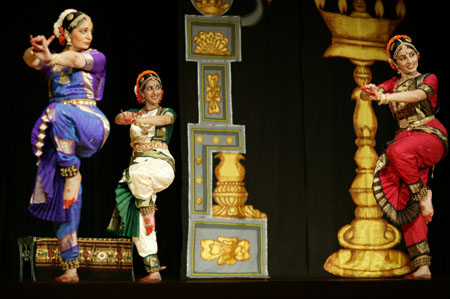
2)Kathakali, a popular dance style of Kerala state in South India.
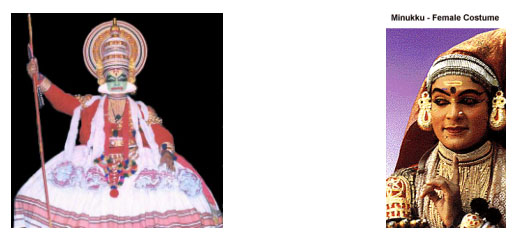
The above images are of typical male and female performers in Katha Kali, representing characters from Hindu mythology
3) Odissi Dance
Dancers performing Odissi dance
4) Kathak, a style popular in North India, has its roots in Lucknow, in Uttar Pradesh, and in Jaipur, in Rajasthan.
5) Manipuri dance, which has its origin in the state of Manipur.
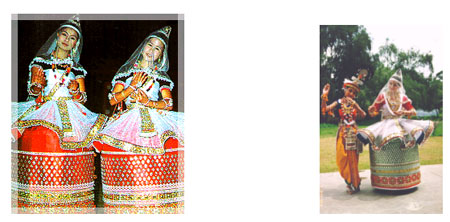
Manipuri dance performance
6) Kuchipudi, a style popular in the southern state of Andhra Pradesh, traces its origin to the village of Kuchipudi in Andhra Pradesh.
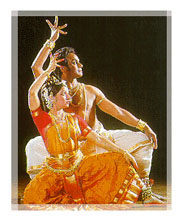
7)Mohini Attam, which is popular in Kerala and is performed exclusively by women.
BHARATA NATYAM

Bharata Natyam is the oldest and most popular classical dance style of India. Therefore, the rest of this article will be devoted to a discussion of this style. It is believed that Lord Brahma created Bharatha Natyam as the fifth Veda. Brahma did so at the request of the gods, who wanted an activity that was physically, mentally, and spiritually stimulating, and at the same time entertaining. Brahma created the fifth veda, called Natya Veda, by combining the essence of the existing four Vedas—Rig Veda, Yajur Veda, Sama Veda, and Atharvana Veda. He then handed it to Indra, the king of the gods, who found it difficult to comprehend; the job was therefore given to sage Bharata, who wrote the Natya Sastra. The Natya Sastra is the oldest text on dance in existence and the most complete work ever to be done in that field.
Another popular explanation for the name Bharata Natyam is that the name Bharata is composed of the first syllables of the following words: Bhava, or mood; Raga, or melody; and Tala, or rhythm. Thus, Bharata Natyam is a combination of mood, melody and rhythm. Bharata Natyam is closely intertwined with Hindu beliefs, mythology, and Carnatic music, the classical music of South India which is the foundation of dance. A dancer must have a thorough knowledge of classical music in order to achieve mastery in choreography in the field of dance.
THE SIGNIFICANCE OF THE NATARAJA STATUE
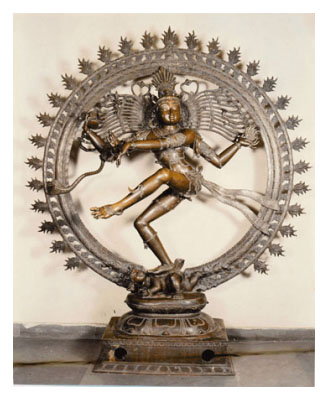
Nataraja, or dancing Shiva, symbolizes the action of cosmic energy, which is the creation, preservation, and destruction of the universe. The cosmic dance of Shiva represents five activities of the Lord:
· Srishti, or creation, attributed to Brahma
· Sthithi, or preservation, attributed to Vishnu
· Samhara, or destruction, attributed to Rudra
· Tirobhava, or illusion, attributed to Maheshwara
· Anugraha, or salvation, attributed to Sadashiva
In the statue of Lord Nataraja the outstretched right hand holding the drum represents creation. The other right hand in front with the fingers pointing up represents preservation. The left outstretched hand holding fire represents destruction. The right leg trampling the demon Muyalagan, represents illusion. The left leg lifted up and stretched to the right with the toe pointing up represents salvation.
MPORTANT ASPECTS OF BHARATANATYAM
:
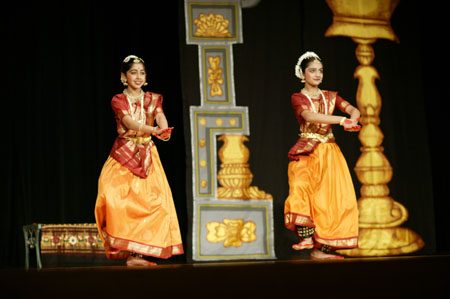
The three important aspects of Bharata Natyam are Nritta, Nritya, and Natya. Nritta is comprised of pure dance movements performed strictly to tala, or rhythm. In Nritta there is no usage of bhava, or emotion, and the dancer does not depict a theme or tell a story. Dance movements are without any special meaning and only represent pure Bharata Natyam technique. Good examples of Nritta are Alarippu, Jathiswaram and Thillana.
Nritya emphasizes bhava, or expressing different emotions through facial expression; hence abhinaya, or facial expression, is the key element of Nritya. The dancer depicts a theme or tells a story through body movements, hand gestures (hastas), and facial expressions (abhinaya). Padams, Javali, and Varnam are good examples of Nritya.
Natya is the combination of dancing and acting. Dance dramas are good examples of Natya. In a dance drama, a story is enacted and the dancers dress up as the different characters they are depicting in the story.
HASTAS OR HAND GESTURES:
Hastas are the vehicle of dance language. Any idea, emotion, or episode can be effectively communicated with the help of hand gestures. There are two kinds of Hastas: Asamyutha Hastas, or single-hand gestures, and Samyutha Hastas, or double-hand gestures. Nandikeshwara’s Abhinaya Darpana describes twenty-eight Asamyutha Hastas and twenty-three Samyutha Hastas. Bharata’s Natya Shastra describes twenty-four Asamyutha Hastas and thirteen Samyutha Hastas.
ARANGETRAM
Arangetram in Tamil means “ascending the stage”. Arangetram marks the completion of the initial training in Bharata Natyam. In the traditional Bharata Natyam training, a student learns the fundamentals of dance and over the years learns to perform one full set of Bharata Natyam repertoire, which consist of 10-12 dance items including Alarippu, Jathiswaram, Varnam, Padam, Javali, and Thillana. Many years may pass before the Guru deems the student worthy of a solo public performance. With the Guru’s permission, the student performs a solo recital, encompassing the entire spectrum of Bharata Natyam dances, in the presence of other dancers, scholars, and art lovers. The student dedicates this performance to the Guru and to Lord Nataraja. Arangetram marks an important milestone in a dancer’s career and is a major stepping stone in her spiritual journey as an artist. This enriching experience helps the student develop confidence and blossom into a mature dancer.
BIOGRAPHIC DATA:
The contributor of this article is Smt. Madhu Nath, a resident of Midland, Texas. She is the founder and director of Vaishnavi Dance Academy, a dance school dedicated to training students in Bhrarata Natyam. Madhu was trained in Bharata Natyam by Sri. U.S. Krishna Rao and Smt Chadrabhaga Devi and Smt. Narmada of Bangalore, South India. Her dance school has presented several dance productions such as ‘Navyug’, ‘Nrithya Lahari’, ‘Moods and Melodies’, ‘Krishna’ ‘Om Shakti’ and ‘Dashavatara’.